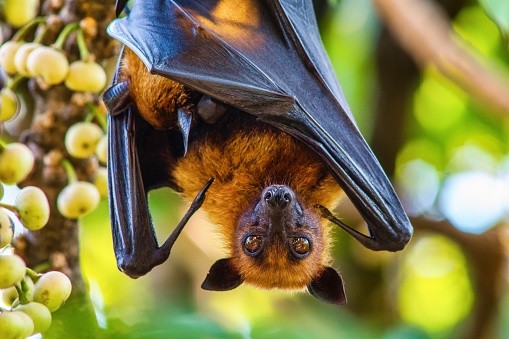MERS is a viral respiratory infection that was initially identified in Saudi Arabia back in 2012. It is caused by the MERS coronavirus (MERS-CoV), which is a member of the coronavirus family. Coronaviruses are a group of viruses that can cause a range of illnesses in humans, from the common cold to severe respiratory diseases like SARS and MERS, as presented by the World Health Organization (WHO).
Predicting spillover risk is a crucial task for public health officials as it allows them to prepare for potential outbreaks of infectious diseases. Recently, researchers made an unexpected finding while studying close bat virus relatives of the Middle East respiratory syndrome (MERS) coronavirus. This discovery has implications for our understanding of the potential for these viruses to spill over into human populations.
The MERS virus is primarily transmitted to humans through close contact with infected camels although there have been a few instances of human-to-human transmission. The virus can cause severe respiratory illness, with symptoms including fever, cough, and difficulty breathing. In some cases, it can lead to severe respiratory failure and even death, as per the Centers for Disease Control and Prevention (CDC).
The Outbreak of Middle East Respiratory Syndrome
New research shows that two bat virus relatives of the Middle-East Respiratory Syndrome (MERS) coronavirus use bat ACE2 receptors as an entry point into cells. Although these receptors are similar to human ACE2 receptors, the viruses in question, called NeoCoV and PDF-2180, only weakly bind to human ACE2 receptors. It is not known if these viruses can cause disease outbreaks in people. MERS uses a different cell receptor called DPP4 while the coronavirus that causes COVID-19, SARS-CoV-2, uses human ACE2 receptors. The research was conducted by an international team and was published in the December 7 edition of Nature.
This finding suggests that the MERS virus may have originated in bats and then spilled over into camels, rather than the other way around. It also highlights the potential for these bat viruses to spill over into human populations.
The researchers also identified several genetic mutations in the bat viruses that could increase their ability to infect humans. This is concerning because it suggests that these viruses have the potential to evolve and become more dangerous to humans.
The discovery that ACE2 is the host cell receptor for NeoCoV and PDF-2180, which are related to the deadly human pathogen MERS-CoV, was unexpected and creates new opportunities for preparing for the potential zoonotic transmission of these viruses in the future, according to the researchers in this study. This information is crucial for creating a watch-list of animal virus families that pose a risk of emerging as zoonotic diseases in humans.

The closest bat virus relatives of the human Middle-East Respiratory Syndrome (MERS) coronavirus efficiently bind to bat ACE2 receptors as an entry point into these cells, which have some similarities to the ACE2 receptors in human cells, according to new research published in the journal Nature.
ALSO READ: Coronavirus Epidemic in East Asia Started 20,000 Years Ago, Study Claims
Explaining Bat Coronaviruses
As reported by SciTech Daily, the team explained that the lack of knowledge about which cell receptors bat coronaviruses use limits our understanding of their cell entry strategies and their ability to transmit between species. They also noted in the paper that the complexities of how coronaviruses use cell receptors emphasize the need for more research and surveillance on these viruses to be prepared for future outbreaks.
In this study, the researchers aimed to collect data that could shed light on the origin of MERS-CoV. Their findings support earlier theories that MERS-CoV may have originated from a genetic recombination event between a virus similar to NeoCoV and a virus that prefers the DPP4 cell receptor.
Scientists speculate that this type of genetic recombination in viruses can occur when a host animal is infected with different coronaviruses at the same time. In this way, a new coronavirus can arise and potentially expand its host range by using a different cell receptor. However, it is still unclear if this event occurred in bats, camels, or other animals, or when the virus may have switched to a new animal or human host.
Diverse Merbecoviruses
In this study, the researchers focused on two viruses, NeoCoV and PDF-2180, which prefer the ACE2 cell receptors in vesper bats. Most merbecoviruses are found in this species of bat, which is diverse and widely dispersed. While NeoCoV does not have a strong affinity for the ACE2 receptor in human cells, the scientists noted that it could undergo adaptive changes that allow it to enter human cells more easily.
The extensive mutations in the key cell binding regions of the COVID-19 virus (SARS-CoV-2) in the Omicron variant suggest that other coronaviruses may also have the potential to adapt through mutations. However, the transition from one animal species to another is complex and involves not just recognizing a cell receptor in the new species but also evading the host's immune response and other factors.
They also mentioned that MERS-CoV antibodies and antibodies generated by current COVID-19 vaccines do not effectively neutralize NeoCoV and PDF 2180. However, their results showed that broadly neutralizing antibodies that target evolutionarily conserved regions of these viruses do inhibit their entry into cells. They suggest that these broader-acting antibodies should be considered for preparedness against the potential spillover of these viruses to humans.
RELATED ARTICLE: COVID-19 Origin: Did Virus Escape from Lab or a Natural Emergence?
Check out more news and information on COVID-19 on Science Times.










!['Cosmic Glitch' in Einstein's Theory of General Relativity Could Be Explained in This New Scientific Tweak [Study]](https://1721181113.rsc.cdn77.org/data/thumbs/full/53435/258/146/50/40/cosmic-glitch-in-einsteins-theory-of-general-relativity-could-be-explained-in-this-new-scientific-tweak-study.jpeg)



